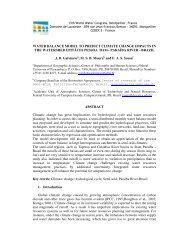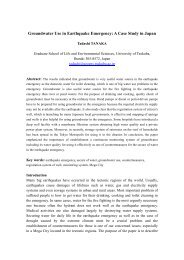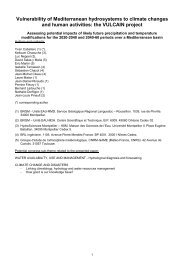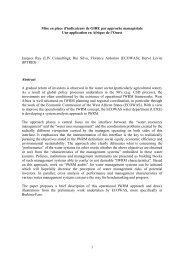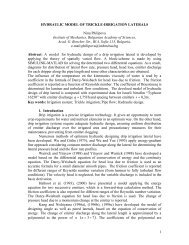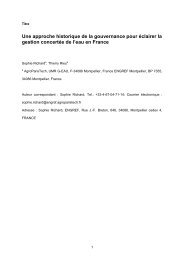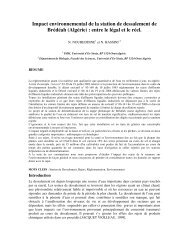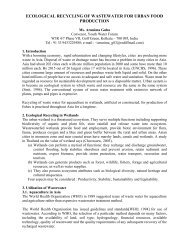An abstract of no more than 500 words must be submitted ... - IWRA
An abstract of no more than 500 words must be submitted ... - IWRA
An abstract of no more than 500 words must be submitted ... - IWRA
You also want an ePaper? Increase the reach of your titles
YUMPU automatically turns print PDFs into web optimized ePapers that Google loves.
Who gets what<br />
Policy lessons on how to share scarce irrigation water during droughts<br />
Authors:<br />
Deborah Peterson, Productivity Commission, Australia<br />
Jean-Michel Salles, CNRS, UMR Lameta, Montpellier, France<br />
Sophie Thoyer, SupAgro, UMR Lameta, Montpellier, France<br />
Corresponding author:<br />
Pr. Sophie Thoyer<br />
SupAgro – Lameta – 2 place Viala<br />
34060 Montpellier cedex 1 France<br />
Tel: (33) (0)4 99 61 22 18<br />
Fax: (33) (0) 4 67 54 58 05<br />
Email: thoyer@supagro.inra.fr<br />
Oral presentation<br />
Congress sub-theme: Water availability, use and management<br />
Abstract<br />
With climate change, a num<strong>be</strong>r <strong>of</strong> regions in the world are forecast to face <strong>more</strong> frequent and<br />
<strong>more</strong> severe droughts, forcing the irrigated agricultural sector – <strong>of</strong>ten a major consumer in<br />
summer periods- to face water restrictions. One <strong>of</strong> the main challenges for policy-makers is to<br />
design mechanisms for sharing water among farmers, which can <strong>be</strong> rapidly and easily enforced,<br />
while ensuring that water is efficiently allocated without creating unnecessary inequity.<br />
Where there are <strong>no</strong> markets for water, a regulatory approach to managing demand for irrigation<br />
water is <strong>of</strong>ten employed – for example, irrigators are permitted to water only on certain<br />
days. However, <strong>be</strong>tween competitive markets and regulatory individual restrictions, there is a<br />
wide range <strong>of</strong> other solutions.<br />
This paper examines alternative approaches to managing irrigation water in drought periods.<br />
The efficiency, effectiveness and feasibility <strong>of</strong> each instrument is considered and compared<br />
with the regulatory approach. Case studies, where examples exists, in Australia, USA, and<br />
France are briefly analysed.<br />
The paper focuses exclusively on the policy solutions dealing with temporary, unforeseeable<br />
deficits, associated with an exceptionally dry season and low reserves. It therefore has to take<br />
into account the short-term constraints <strong>of</strong> farmers who may have to face restrictions at short<br />
<strong>no</strong>tice.<br />
Key-<strong>words</strong> : drought, efficiency, equity, policy tools, use and management rights
Introduction<br />
With climate change, a num<strong>be</strong>r <strong>of</strong> regions in the world are forecast to face <strong>more</strong> frequent and<br />
<strong>more</strong> severe droughts (IPCC, 2007), forcing the irrigated agricultural sector – <strong>of</strong>ten a major<br />
consumer in summer periods- to face water restrictions. One <strong>of</strong> the main challenges for<br />
policy-makers is to design sharing mechanisms, which can <strong>be</strong> rapidly and easily enforced,<br />
while ensuring that water is efficiently allocated without creating unnecessary inequity. The<br />
paper focuses exclusively on the policy solutions dealing with temporary, unforeseen deficits,<br />
associated with an exceptionally dry season and low reserves. It does <strong>no</strong>t descri<strong>be</strong> policies<br />
seeking to reconcile long-term supply and demand trends, by encouraging water-saving<br />
choices and tech<strong>no</strong>logies or by increasing water reserves or alternative supply.<br />
The type <strong>of</strong> feasible solutions depends very much on the types <strong>of</strong> water rights in place. The<br />
security <strong>of</strong> rights and the scarcity-sharing provisions are highly variable. They will define the<br />
level <strong>of</strong> risk faced by the right-holder and the relative importance <strong>of</strong> market-like versus<br />
regulatory solutions. Indeed, <strong>be</strong>tween competitive markets and regulatory individual<br />
restrictions, there is a wide range <strong>of</strong> other solutions which have <strong>be</strong>en experienced or could <strong>be</strong><br />
tested in the future. This paper examines the main alternative eco<strong>no</strong>mic approaches to<br />
managing irrigation water in drought periods: flexibility mechanisms to reallocate water; risktransfer<br />
mechanisms to reduce global risk; and global incentives or constraints. The<br />
efficiency, effectiveness and feasibility <strong>of</strong> each instrument is considered and compared with<br />
the pure regulatory approach.<br />
The paper is structured as follows: the first section highlights risk-sharing mechanisms in<br />
water right systems and the consequent constraints faced by farmers. The second section<br />
descri<strong>be</strong>s water reallocation mechanisms. The third section descri<strong>be</strong>s risk transfer policies<br />
and the fourth section concludes.<br />
1. Why it is difficult to define droughts and why it is needed<br />
There is <strong>no</strong> universal definition <strong>of</strong> drought since it is a <strong>no</strong>tion <strong>of</strong> “shortage”: it therefore<br />
depends on demand as well as supply. The droughts we are interested in, are temporary<br />
drought, in other <strong>words</strong>, periods <strong>of</strong> time during which the supply <strong>of</strong> water does <strong>no</strong>t meet the<br />
demand in the form it is expressed through the existing water management institutions. It can<br />
therefore easily <strong>be</strong> understood that the severity <strong>of</strong> the consequences <strong>of</strong> a drought will <strong>be</strong><br />
strongly correlated with the ability <strong>of</strong> these institutions to forecast it. What is the degree <strong>of</strong><br />
“predictability” <strong>of</strong> a drought The long term meteorological forecast are improving but seems<br />
to remain unable to give robust prediction on water seasonal availabilities.<br />
Nevertheless, policy-makers need to have an indicator <strong>of</strong> drought severity in order to: provide<br />
alert; set-up sharing mechanisms; sometimes pay compensation associated with “natural<br />
disaster”.<br />
It <strong>must</strong> <strong>be</strong> emphasized that drought differs from other natural hazards in several ways. Firstly,<br />
it is a "creeping phe<strong>no</strong>me<strong>no</strong>n", making its onset and end difficult to determine. The effects <strong>of</strong><br />
drought accumulate slowly over long periods. Secondly, the absence <strong>of</strong> a precise and<br />
universally accepted definition <strong>of</strong> drought adds to the confusion about whether or <strong>no</strong>t a<br />
drought exists and, if it does, its severity. Thirdly, drought impacts are less obvious and <strong>of</strong>ten<br />
spread over a larger and imprecise geographical area <strong>than</strong> are damages that result from other<br />
natural hazards. Drought seldom results in structural damage. For these reasons the<br />
quantification <strong>of</strong> impacts and the provision <strong>of</strong> disaster relief is a far <strong>more</strong> difficult task for<br />
drought <strong>than</strong> it is for other natural hazards.
It is critical to <strong>no</strong>te that the eco<strong>no</strong>mic, social, and environmental impacts <strong>of</strong> drought are the<br />
product <strong>of</strong> both the natural event (i.e. meteorological drought) and the vulnerability <strong>of</strong> society<br />
to extended periods <strong>of</strong> precipitation deficiency. Expressed in a<strong>no</strong>ther way, the impacts that<br />
result from future drought occurrences will <strong>be</strong> determined <strong>no</strong>t only by the frequency and<br />
intensity <strong>of</strong> meteorological drought but also by the num<strong>be</strong>r <strong>of</strong> people at risk and their degree<br />
<strong>of</strong> exposure to this risk. If demand for water and other shared natural resources is increasing<br />
societal vulnerability to water supply interruptions caused by drought, then future droughts<br />
can <strong>be</strong> expected to produce greater impacts, with or without any increase in the frequency and<br />
intensity <strong>of</strong> meteorological drought.<br />
In most cases, public authorities react to drought through the provision <strong>of</strong> relief or emergency<br />
assistance to the affected areas or sectors (i.e., crisis management approach). By following<br />
this approach, drought only receives the attention <strong>of</strong> decision makers when it is at peak levels<br />
<strong>of</strong> intensity and spatial extent and when water management options are quite limited… This<br />
reactive approach is <strong>no</strong>t an efficient policy and <strong>must</strong> <strong>be</strong> replaced as <strong>of</strong>ten as possible by<br />
anticipatory, preventive approaches that reduce risk (i.e., risk management) through the<br />
adoption <strong>of</strong> appropriate mitigation programs and policies.<br />
The focus on reactive approach can <strong>of</strong>ten <strong>be</strong> explained by the difficulty to characterise the<br />
kind <strong>of</strong> situation that should <strong>be</strong>nefit <strong>of</strong> <strong>more</strong> preventive approaches. Shortage can <strong>more</strong> easily<br />
<strong>be</strong> answered by organizing the sharing <strong>of</strong> scarcity, <strong>more</strong> or less efficiently, <strong>more</strong> or less<br />
equitably, and developing future supply through management structure like reservoirs and<br />
canals. These policies that met some success in the past are <strong>no</strong>w confronted to their own<br />
limits: the potential to cost effective infrastructure is <strong>no</strong>w mainly exhausted. More over it is<br />
generally inappropriate –cost ineffective- for unforeseeable temporary drought that need<br />
responses in the short run, at least to avoid their most costly consequences.<br />
The consequences are that planned activities and input expenditures do <strong>no</strong>t coincide any<strong>more</strong><br />
with the availability <strong>of</strong> the water input: farmers end up lower on the production function and<br />
support sunk costs: revenue losses due to lower yields, lower quality <strong>of</strong> harvest , potentially<br />
market share losses or loss <strong>of</strong> contracts.<br />
Facing a temporary drought, the reactive response consists in three main ways:<br />
- setting up early alert systems to encourage water conservation <strong>be</strong>haviour<br />
- implementation <strong>of</strong> use restrictions usually pre-defined in drought management plans<br />
(when they exist)<br />
- when necessary, implementing rights to compensation<br />
For all these purpose, an administrative definition <strong>of</strong> temporary drought is needed, and it can<br />
<strong>be</strong> observed that many States or river basin institutions have adopted an <strong>of</strong>ficial definition <strong>of</strong><br />
drought with a num<strong>be</strong>r <strong>of</strong> quantitative indicators. These definitions may sensibly differ,<br />
accordingly with the kind <strong>of</strong> issue anticipated and the type <strong>of</strong> information available.<br />
Many policy response are implemented according to the existing legal system. When the<br />
water management rests on annual licenses: the choice is <strong>be</strong>tween <strong>no</strong>t renewing a part <strong>of</strong> the<br />
licenses in the drought affected region, following priority schemes, and renewing all the<br />
licenses, but with a reduced quantity <strong>of</strong> water (both cases are likely to result in calls for<br />
compensation). Since the water authority is unlikely to get perfect information on the<br />
marginal values <strong>of</strong> water use, both are inefficient means <strong>of</strong> reduction. They are probably<br />
unfair since in both cases, farmer <strong>be</strong>ars all costs (may <strong>be</strong> able to share if can produce<br />
something and if output prices received rise in drought).<br />
Other regulation can <strong>be</strong> implemented:<br />
- limit the amount <strong>of</strong> water applied per farm (for example, some percentage <strong>of</strong> the licensed<br />
amount, or some percentage <strong>of</strong> the amount used last year or average <strong>of</strong> recent years)
- limit production on farm (for example, <strong>no</strong> production on a certain num<strong>be</strong>r <strong>of</strong> acres)<br />
- Impose restrictions on time <strong>of</strong> irrigation (for example, can only water in the evening, or<br />
on certain days)<br />
- Impose restrictions based on method <strong>of</strong> irrigation (for example, only drip irrigators may<br />
irrigate)<br />
- impose restrictions based on place <strong>of</strong> irrigation<br />
- tie restrictions on water use to drought assistance<br />
Since there is information asymmetry and limited enforcement or implementation capacity,<br />
all these measure appear as inefficient means <strong>of</strong> reduction, and may result in calls for<br />
compensation. Moreover:<br />
- Transactions costs may <strong>be</strong> high (monitoring, enforcement)<br />
- If based on method or irrigation, will affect investment in tech<strong>no</strong>logy (if policy is thought<br />
to <strong>be</strong> long run)<br />
- If based on amount <strong>of</strong> water used in previous years, will <strong>be</strong> an incentives to use <strong>more</strong><br />
water in the future<br />
2. Scarcity-sharing mechanisms embodied in water rights<br />
In some country, there exist currently several water right systems that involve the capacity to<br />
adapt to drought periods. According to their design they are associated with a varying level <strong>of</strong><br />
security for their holders. A water right is an entitlement (provisory or permanent) but it does<br />
<strong>no</strong>t guarantee that the resource is available since water quantities are contingent upon climate<br />
conditions and decisions <strong>of</strong> upstream users.<br />
In the following paragraphs these systems will <strong>be</strong> briefly descri<strong>be</strong>d and the scarcity-sharing<br />
provisions <strong>of</strong> each systems will <strong>be</strong> emphasized: from very secure/insecure (senior rights in<br />
California) to the proportional share in Australia, or the regulatory restrictions in France. It<br />
can easily <strong>be</strong> shown (see Figure 1.) that either rights lose their value or regulatory authorities<br />
need to step in to reduce rights one way or a<strong>no</strong>ther. In such case, due to information<br />
asymmetries it is <strong>no</strong>t sure at all that the restrictions will affect the lowest marginal uses.<br />
1) Proportional rights : the Australian case<br />
In Australia, water rights are administered on the basis <strong>of</strong> a patchwork <strong>of</strong> statutory and<br />
riparian common law. State governments can alter water entitlements either by enacting new<br />
legislation or by adopting regulatory provisions on the scarcity-sharing rules in periods <strong>of</strong> low<br />
supplies. For example, in South Australia where water supply is <strong>of</strong> relatively high security,<br />
the government is entitled to temporarily readjust water allocation through proportional<br />
curtailment (to some extend similar to the French system). In New South Wales, there are<br />
high security and low security (general) entitlements. If water supply is low, the high security<br />
entitlements are satisfied <strong>be</strong>fore and the low security entitlements <strong>be</strong>ar the brunt <strong>of</strong> the<br />
restrictions.<br />
2) “Prior appropriation”: Californian water rights<br />
In California, water rights pertain to the appropriation doctrine. It is a use-based rather <strong>than</strong><br />
land-based system <strong>of</strong> property rights which traditionally applied to direct flow diversions (and<br />
later to the storage <strong>of</strong> water for subsequent release) on the basis <strong>of</strong> the pioneer principle “first<br />
in time-first in right.” 1 Water rights are appropriative rights, attenuated only by three historic<br />
1 The Doctrine <strong>of</strong> Prior appropriation was established to serve practical demands <strong>of</strong> nineteenth century<br />
water users in the western states <strong>of</strong> the US. It originated in the customs <strong>of</strong> miners on federal public<br />
lands who accorded the <strong>be</strong>st rights to those who first used water. It was later extended to farmers and<br />
other users, including those who privately owned land. Appropriative rights were recognised under the<br />
common law <strong>of</strong> local courts. Water is considered to <strong>be</strong> a public resource and individual can claim a<br />
right to use water if they could demonstrate that water was put to <strong>be</strong>neficial use, initially defined as the
limitations: (i) unused rights are subject to abandonment or statutory forfeiture, (ii) the use <strong>of</strong><br />
rights <strong>must</strong> <strong>no</strong>t <strong>be</strong> wasteful, and (iii) the use <strong>of</strong> rights <strong>must</strong> <strong>be</strong> for a <strong>be</strong>neficial purpose. In<br />
times <strong>of</strong> shortage, rights are allocated by priority: holders <strong>of</strong> senior rights are entitled to take<br />
the full amount <strong>of</strong> their rights regardless <strong>of</strong> what is left for junior right holders, which are cut<br />
back accordingly.<br />
However, the original appropriation doctrine has <strong>be</strong>en progressively supplemented by<br />
administrative management regimes defining rules for the allocation and distribution <strong>of</strong> water,<br />
in order to manage <strong>be</strong>tter conflicting uses and to meet multiple objectives. Actually, in each<br />
<strong>of</strong> the Western States the water right management evolved following different way to face the<br />
growing and changing demand for water use (<strong>of</strong>ten to divert water from agricultural use to<br />
urban use). Water right transfers may <strong>be</strong> subjected to the authorization <strong>of</strong> State engineer who<br />
will check what are the effects <strong>of</strong> the transfer on third party, following the place <strong>of</strong> diversion,<br />
the type <strong>of</strong> use, the rate <strong>of</strong> release, etc., and possibly the degree <strong>of</strong> priority <strong>of</strong> the right.<br />
3) “Use licenses”: the French case<br />
“Use licenses” are, theoretically, delivered annually for a given discharge and a given use by<br />
the State agency <strong>of</strong> each jurisdiction, and can<strong>no</strong>t <strong>be</strong> traded or leased. The agency is expected<br />
to check that the state <strong>of</strong> the resource is sufficient to satisfy all other existing licenses, as well<br />
as, minimum requirements for the environment. In practice, the control <strong>of</strong> uses has <strong>be</strong>en<br />
insufficient, leading to over-allocation and severe summer scarcity in certain areas. Moreover,<br />
although the licenses are potentially renegotiated each year, it is extremely rare that a license<br />
is <strong>no</strong>t re-granted. Therefore, there is an underlying seniority principle in the allocation<br />
process. All new demands are managed through a waiting list, the new available volumes<br />
<strong>be</strong>ing most <strong>of</strong>ten granted by order <strong>of</strong> solicitation.<br />
Early national legislation introduced the principle <strong>of</strong> minimum quotas for the environment in<br />
1964. In times <strong>of</strong> scarcity, minimal flows have to <strong>be</strong> left in rivers to preserve aquatic life. The<br />
remaining water is shared out on a proportional basis <strong>be</strong>tween other users, mainly agriculture<br />
and industry through temporary restriction roster systems managed and controlled by public<br />
authorities. Therefore, water rights in France are substantially attenuated and relatively<br />
insecure. They are contingent both on the state <strong>of</strong> nature and on the decisions <strong>of</strong> the State. The<br />
principle <strong>of</strong> annually renewable licenses tied to a specific use excludes an interpretation <strong>of</strong><br />
water rights as exchangeable titles.<br />
Finally, following the existing water rights 3 ways <strong>of</strong> sharing scarcity when:<br />
i) proportional sharing when rights are defined as a share <strong>of</strong> available water – this is<br />
what is proposed and partially implemented in the Australian system (see Young<br />
and Mc Coll, 2003);<br />
ii) prior appropriation system leads to give the remaining water in period <strong>of</strong> shortage<br />
to the <strong>more</strong> senior rights (the implementation varies among the different US<br />
western state, namely in California, Colorado);<br />
iii) administrative sharing gives to the water authority the responsibility to define<br />
priority among the users that hold the licenses.<br />
Without further development, it can easily <strong>be</strong> understood that there is a strong need for<br />
flexibility mechanisms to reduce both individual losses and collective losses: Three solutions:<br />
- either allow water quantities to <strong>be</strong> allocated to its highest marginal value – water<br />
markets – or when <strong>no</strong>t available water buybacks. When water rights are <strong>no</strong>t tradable,<br />
use <strong>of</strong> shortage pricing to mimic market<br />
- risk-transfer mechanisms to ensure that drought risk is allocated so as to minimize<br />
global risk: water options, water contracts and insurance<br />
- collective incentives to reduce use: education, reward and sanction<br />
application <strong>of</strong> water for agricultural and mining purpose, and since broaden to include household,<br />
commercial, recreational and environmental purpose.
3. Flexibility mechanisms for reallocating water rights<br />
Three main flexibility mechanisms can <strong>be</strong> implemented to pursue efficiency improvement.<br />
Water markets<br />
Competitive markets are usually the most efficient mechanism to allocate scarce resources,<br />
<strong>be</strong>cause the confrontation <strong>of</strong> supply and demand will automatically –through the invisible<br />
hand- reallocate water to where it can yield its highest value. Water markets can <strong>be</strong><br />
operational provided a clear, comprehensive and enforceable property right system exists and<br />
provided that transaction and regulatory costs do <strong>no</strong>t outweigh the potential gains. Water<br />
markets as such do <strong>no</strong>t create additional resources but they allow to re-allocate restrictions<br />
imposed by scarcity (in the case <strong>of</strong> proportional restrictions or in the case <strong>of</strong> priority rights) in<br />
a <strong>more</strong> efficient way.<br />
Moreover, the existence <strong>of</strong> market mechanisms is expected to improve on-farm water-use<br />
decisions with regard to drought risks by turning the input rationing risk (limited amount <strong>of</strong><br />
water leading to irreversible losses for cattle or perennial crops) into an input price risk (with<br />
greater water expenditures <strong>than</strong> expected). This last risk can <strong>be</strong> <strong>more</strong> easily accepted by<br />
farmers <strong>be</strong>cause savings or access to the credit market can provide acceptable coverage.<br />
Public buybacks<br />
<strong>An</strong>other way for public authorities to organize rationing is to organize market-like public<br />
buybacks: such public purchases can <strong>be</strong> organized through procurement auctions. It is the<br />
case <strong>of</strong> the case <strong>of</strong> the Flint River Drought Protection Act (enacted in 2001) in the Georgia<br />
state. The objective is to reduce irrigated acreage in periods <strong>of</strong> drought in order to maintain<br />
acceptable river flows. Technical water services evaluate the risk <strong>of</strong> an upcoming drought by<br />
the 1st <strong>of</strong> March <strong>of</strong> each year (looking at water stocks, permits issued, weather forecasts and<br />
statistics). If a drought is declared, then the buyback process can <strong>be</strong> initiated and has to take<br />
place within the following 25 days. It is implemented through an "auction-like" process in<br />
which farmers <strong>of</strong>fer (voluntarily) to forego irrigation on all acreage covered by a given water<br />
use permit for the remainder <strong>of</strong> the calendar year in exchange for a one-time lump sum<br />
payment determined by the auction process. A given budget is set aside to compensate those<br />
farmers. Farmers can still use the land for rain-fed production.<br />
Other equivalent mechanisms include water banks as a means <strong>of</strong> temporarily modifying water<br />
allocation procedures during water shortages. The California Drought Water Bank program is<br />
an example <strong>of</strong> an in<strong>no</strong>vative and successful mitigation action (California Department <strong>of</strong><br />
Water Resources, 1992). This program was created in 1991. It allowed the Department <strong>of</strong><br />
Water Resources to acquire water in three ways: (1) by purchasing water from farmers who<br />
chose <strong>no</strong>t to irrigate; (2) by purchasing surplus water from local water districts; and (3) by<br />
paying farmers or water districts to use ground water instead <strong>of</strong> surface water. MacDonnell et<br />
al. (1994) present a review <strong>of</strong> water banking in the West.<br />
Variable pricing<br />
In the short run, the total quantity <strong>of</strong> water in a water supply system and/or the system<br />
delivery capacity is generally fixed. Since volumetric pricing (charging based on the volume<br />
<strong>of</strong> water consumed) affects the quantity <strong>of</strong> water demanded, such prices could <strong>be</strong> used during<br />
periods <strong>of</strong> drought to equate demand and supply (Varela-Orega et al, 1998) . 2 Using<br />
volumetric prices to ration fixed supplies is eco<strong>no</strong>mically efficient: water users adjust their<br />
water use until their marginal <strong>be</strong>nefits equal the the marginal cost (the price <strong>of</strong> water). If<br />
2 A volumetric price will have <strong>no</strong> effect <strong>of</strong> the quantity <strong>of</strong> water consumed if demand in the relevant<br />
price range is already constrained; the change in price needs to <strong>be</strong> sufficiently large.
water users have <strong>no</strong> fixed allotment <strong>of</strong> water, or if they can freely trade their water allotments,<br />
this will ensure that water is distributed to users who place the highest value on the water. 3<br />
However, volumetric variable pricing requires that it is possible to measure the volume <strong>of</strong><br />
water <strong>be</strong>ing used. Pricing structures that involve changes in price at different times or in<br />
different situations requires meters to <strong>be</strong> read at the point <strong>of</strong> change. . There are costs in<br />
providing metering infrastructure and reading meters. These costs need to <strong>be</strong> evaluated<br />
against the <strong>be</strong>nefits <strong>of</strong> introducing or changing pricing arrangements.<br />
Formulation <strong>of</strong> pricing policies to address drought requires some k<strong>no</strong>wledge <strong>of</strong> the price<br />
elasticities <strong>of</strong> demand for water. Also relevant is the cross-elasticity <strong>of</strong> price with income,<br />
since the price responsiveness <strong>of</strong> demand for water depends on the income levels <strong>of</strong> water<br />
users (Howe 2005). With highly inelastic demands, a large change in price is needed to have a<br />
significant impact on quantity demanded. Because <strong>of</strong> this, using price to ration demand has<br />
<strong>of</strong>ten <strong>be</strong>en viewed s politically unacceptable.<br />
Ideally, with full information, pricing could mimic the sale outcomes <strong>of</strong> a perfectly<br />
functioning market. However, if there are significant threshold effects and uncertainty about<br />
<strong>be</strong>ing able to stay <strong>be</strong>low a certain target, policy makers may prefer quantity regulations or a<br />
combination <strong>of</strong> price and quantity.<br />
4. Risk-transfer mechanisms: Option contracts and interruptible contracts<br />
The preceding section presented ways to allocate scarce water to its highest value use when<br />
drought is already there. We have shown that market or market-like mechanisms are<br />
theoretically the most efficient to maximize the total use value <strong>of</strong> available water. However,<br />
they come at a high cost for risk-averse users <strong>be</strong>cause they do <strong>no</strong>t reduce overall risk. <strong>An</strong>other<br />
–potentially complementary- response to drought threat is to set-up risk-transfer mechanisms<br />
in order to reach a <strong>more</strong> efficient ex-ante sharing <strong>of</strong> hydrological risks and therefore to avoid<br />
inefficient self-insurance strategies or costly investments in water supply alternatives.<br />
It is a fact that water users who are risk averse or with greater vulnerability to water scarcity<br />
have a greater willingness to pay for secure and reliable access to water. There is thus scope<br />
thus to transfer risks associated with water shortage from this category <strong>of</strong> users to the <strong>more</strong><br />
risk-prone, less drought vulnerable users, in exchange for a compensation payment. The<br />
underlying idea is to set-up water option markets in which the purchaser <strong>of</strong> the option gains<br />
the right to buy a minimum quantity <strong>of</strong> water at a pre-specified price (called the striking or<br />
exercise price) over a given period from the seller <strong>of</strong> the option. The seller <strong>of</strong> the option is<br />
thus guaranteeing future delivery under specified conditions and price. In exchange, a further<br />
premium above the striking price –called the option price – is paid to the seller. This premium<br />
can <strong>be</strong> paid annually over the duration <strong>of</strong> the contract or as a lump-sum at the time <strong>of</strong><br />
signature. Hertzler (2004) refers to this system as “exotic options” <strong>be</strong>cause the quantity is a<br />
random variable as opposed to price. A water option is also different from a financial option<br />
<strong>be</strong>cause there is <strong>no</strong> transfer <strong>of</strong> property, the entitlement is retained by option seller.<br />
Existing literature has envisaged option contracts <strong>be</strong>tween the agricultural sector and<br />
municipalities to improve the reliability <strong>of</strong> urban water supply (Michelsen and Young, 1993;<br />
Gomez-Ramos and Garrido, 2004), <strong>be</strong>tween the agricultural sector and hydropower<br />
companies to firm up electric power production (Hamilton et al, 1989), or <strong>be</strong>tween irrigators<br />
and the environment to ensure minimum flows in rivers in drought period (Heaney and Hafi,<br />
2005). In all cases descri<strong>be</strong>d in the literature, irrigators are the sellers <strong>of</strong> water options.<br />
Empirical studies cited above demonstrate that the option value, which is the maximum<br />
3 <strong>An</strong>other function <strong>of</strong> water prices is provision <strong>of</strong> revenues for the water supply authority. Here, we call<br />
such ‘prices’ an administered charge, and treat this separately from prices related to water scarcity.
eco<strong>no</strong>mic <strong>be</strong>nefit <strong>of</strong> an option contract – and therefore the maximum price a purchaser would<br />
<strong>be</strong> willing to pay for the option – is <strong>of</strong>ten greater <strong>than</strong> alternative arrangements such as<br />
investments in water conservation strategies or in alternative supplies. Part <strong>of</strong> this option<br />
value is paid –even if the option is <strong>no</strong>t exercised- to the irrigators as an incentive to enter into<br />
an option contract: it is the option payment and is negotiated <strong>be</strong>tween the purchaser and the<br />
seller. The remaining value is the net <strong>be</strong>nefit to the holder <strong>of</strong> a water option contract.<br />
Irrigators will participate if the option value increases their expected income and/or reduces<br />
their income variability. In practice, compensation schemes <strong>of</strong>ten combine annual payments –<br />
to <strong>of</strong>fset average expected loss - with lump sum payments in years <strong>of</strong> water supply<br />
interruption. In this way both parties can increase incomes and reduce income risks without<br />
having to anticipate fully the num<strong>be</strong>r and severity <strong>of</strong> droughts.<br />
In the French context, it could <strong>be</strong> envisaged to set-up option contracts <strong>be</strong>tween different<br />
groups <strong>of</strong> farmers competing for the same water resource: one category <strong>of</strong> irrigators willing to<br />
accept temporary suspension <strong>of</strong> irrigation operations (ie irrigation <strong>of</strong> pastures or low value<br />
annual crops) could sell “water-access” options to a<strong>no</strong>ther category <strong>of</strong> irrigators with<br />
perennial or high value drought-prone crops. The “water-access” option would <strong>be</strong> a<br />
commitment to accept a greater share <strong>of</strong> the restrictions imposed by administrative authorities<br />
in case <strong>of</strong> drought. It would allow the second group to increase the reliability <strong>of</strong> their supply<br />
at a pre-arranged costs that may <strong>be</strong> preferred over other alternatives (invest in <strong>more</strong> storage<br />
capacity, dig wells, change cropping patterns).<br />
<strong>An</strong>other comparable solution is the signature <strong>of</strong> interruptible contracts –similar to electricity<br />
supply contracts - <strong>be</strong>tween water users and water supply facilities. The “price <strong>of</strong> the option”<br />
in this case is the price discount that the water supplier will <strong>of</strong>fer to the water consumer in<br />
exchange for the right to interrupt water delivery under pre-specified circumstances. Such<br />
contracts could <strong>be</strong> established <strong>be</strong>tween urban water services and some households –such as<br />
the owners <strong>of</strong> holiday houses who could then decide <strong>no</strong>t to inhabit their houses during the<br />
interruption period -, or <strong>be</strong>tween a reservoir dam operator and irrigators downstream.<br />
Conclusion<br />
While a regulatory approach, depending on its design, can <strong>of</strong>fer advantages in terms <strong>of</strong> low<br />
administrative transactions costs, it provides the least flexibility to farmers and hence reduces<br />
eco<strong>no</strong>mic efficiency. Pricing approaches requires ability to measure volume or water used.<br />
Increased charges for water will have <strong>no</strong> impact on quantity <strong>of</strong> water used if demand in the<br />
relevant price range is already constrained; in other <strong>words</strong>, the price needs to <strong>be</strong> sufficiently<br />
large which may limit the political feasibility <strong>of</strong> this approach. Market or market-like<br />
mechanisms (such as buyback auctions) will allow to improve the efficiency <strong>of</strong> the allocation<br />
<strong>of</strong> scarce water by improving the revelation <strong>of</strong> the true willingness to pay <strong>of</strong> water users.<br />
However, design <strong>of</strong> such programs is important and direct costs to governments can <strong>be</strong> high.<br />
<strong>An</strong> options contract written against irrigator’s seasonal allocations <strong>of</strong> water could reduce<br />
water used at a significantly lower cost <strong>than</strong> purchasing entitlements. Moreover, by retaining<br />
their entitlements, irrigators have a hedge against the risk <strong>of</strong> decreased water availability in<br />
the future.
Table 1. Synthesis<br />
Instrument Design issues Cost efficacy Efficiency Transaction and<br />
administrative<br />
costs<br />
Em<strong>be</strong>dded scarcity sharing<br />
in water rights<br />
Administrative Decide when<br />
to impose<br />
restrictions<br />
Seniority<br />
Proportional<br />
Flexibility<br />
mechanisms<br />
Through<br />
existing<br />
markets<br />
Through<br />
auction-like<br />
processes<br />
Through<br />
scarcity pricing<br />
Risk-sharing<br />
mechanisms<br />
Option<br />
contracts<br />
Decide on<br />
priority rights<br />
Decide on the<br />
quantity <strong>of</strong><br />
available water<br />
to <strong>be</strong> shared<br />
Need for<br />
strong<br />
transferable<br />
water rights<br />
Need for<br />
transferable<br />
water rights<br />
Need to<br />
calculate<br />
scarcity price<br />
and make it<br />
vary to reflect<br />
present scarcity<br />
–need to have<br />
continuous<br />
metering<br />
Set-up proper<br />
enforcement<br />
mechanisms –<br />
Calculation <strong>of</strong><br />
option price in<br />
the absence <strong>of</strong><br />
markets<br />
No costs<br />
No costs<br />
No costs<br />
No costs<br />
It depends on<br />
the auction<br />
payment rule:<br />
information<br />
rents paid to<br />
bidders can<br />
<strong>be</strong> high<br />
Revenue<br />
generated by<br />
pricing –<br />
increase in<br />
revenue<br />
depends on<br />
price<br />
elasticity <strong>of</strong><br />
demand<br />
Very low<br />
<strong>be</strong>cause <strong>no</strong><br />
guarantee<br />
that water is<br />
allocated to<br />
most efficient<br />
use<br />
Low if senior<br />
rights held by<br />
low marginal<br />
value users<br />
Good<br />
High<br />
provided<br />
markets are<br />
reasonably<br />
competitive<br />
Efficiency is<br />
high provided<br />
that the<br />
payment rule<br />
induces<br />
close-tosincere<br />
bidding<br />
High if<br />
scarcity and<br />
elasticities<br />
are rightly<br />
anticipated<br />
Low – designed<br />
to minimize<br />
control costs<br />
Low<br />
Can <strong>be</strong> limited<br />
with good<br />
information<br />
system on price<br />
Potentially high<br />
to explain the<br />
auction rules and<br />
to set-up the<br />
auction<br />
Potentially high<br />
due to complex<br />
invoicing<br />
No costs High Potentially high<br />
to agree on all<br />
dimensions <strong>of</strong><br />
the contract<br />
(renegotiation,<br />
price adjustment<br />
etc.)<br />
Limitations<br />
Restrictions<br />
on trade<br />
imposed to<br />
limit third<br />
party<br />
externalities<br />
Issue <strong>of</strong><br />
lumpy bids<br />
Threshold<br />
effects due to<br />
price<br />
increments
References<br />
Cummings R.G., Holt C.A. and Laury S.K., 2002. Using laboratory experiments for policy<br />
making: an example from the Georgia irrigation reduction auction. Working paper Georgia<br />
State University, 46 pages.<br />
Cummings R.G., Norton N.A. and Norton V. J., 2001. Enhancing In-stream Flows in the Flint<br />
River Basin: does Georgia have sufficient policy tools Water Policy Working Paper 2001-<br />
002, Georgia State University, 25 pages.<br />
Gomez Ramos A. and Garrido A., 2004. “Formal risk-transfer mechanisms for allocating<br />
uncertain water resources: the case <strong>of</strong> option contracts”, Water Resource Research 40, 1-11.<br />
Hamilton J., Whisttley N. and Halverson, P., 1989. Interruptible water markets in the Pacific<br />
NorthWest, American Journal <strong>of</strong> Agricultural Eco<strong>no</strong>mics 71 (February), 63-75.<br />
Hertzler G., 2004. “Weather derivatives and yield index insurance as exotic options”, 48 th<br />
Conference <strong>of</strong> the Australian Agricultural and Resource Eco<strong>no</strong>mics Society, Melbourne,<br />
February, 14 pages.<br />
Howe C.W., 2005. The functions, impacts and effectiveness <strong>of</strong> water pricing: Evidence from<br />
the United States and Canada.. World Resources Development 21 (1), 43-53.<br />
Johannsson R. C, Tsur Y., Roe T.L., Doukkali R. and Dinar A., 2002. Pricing irrigation water,<br />
a review <strong>of</strong> theory and practice. Water Policy 4, 173-199.<br />
Michelsen A. and Young R., 1993. Optioning agricultural rights for urban water supplies<br />
during drought” American Journal <strong>of</strong> Agricultural Eco<strong>no</strong>mics 75 (4), 1010-1020.<br />
Productivity Commission, 2003. Water Rights Arrangement in Australia and Overseas.<br />
Commission Research paper, Melbourne, Australia, 331 pages.<br />
Productivity Commission, 2006. Rural Water Use and the Environment: The Role <strong>of</strong> Market<br />
Mechanisms. Research Report, Melbourne, Australia, August, 313 pages.<br />
Varela-Ortega C., Sumpsi J., Garrido A., Blanco M., Iglesias E., 1998. Water pricing policies,<br />
public decision making and farmers’ response: implications for water policy, Agricultural<br />
Eco<strong>no</strong>mics 19 (1), 193-202.<br />
Wilhite D.A., 1997. Improving Drought Management in the West: The Role <strong>of</strong> Mitigation and<br />
Preparedness. National Drought Mitigation Center, University <strong>of</strong> Nebraska, report to the<br />
Western Water Policy Review Advisory Commission, January 8.<br />
Young M.D. and Mc Coll J.C., 2003. Robust reform: the case for a new water entitlement<br />
system for Australia, The Australian Eco<strong>no</strong>mic Review 36 (2), 225-234.



